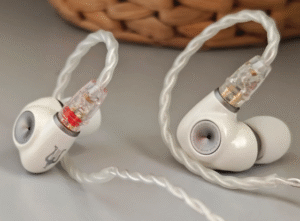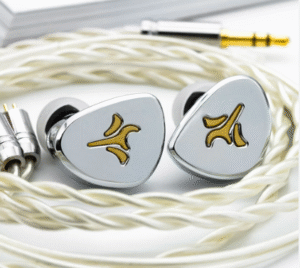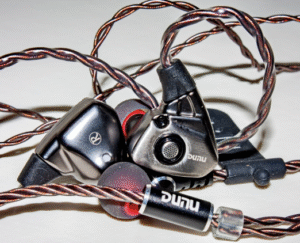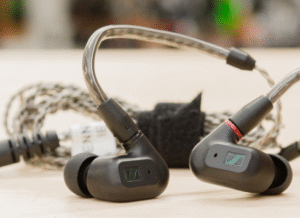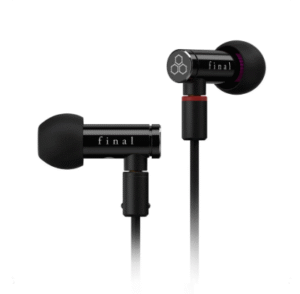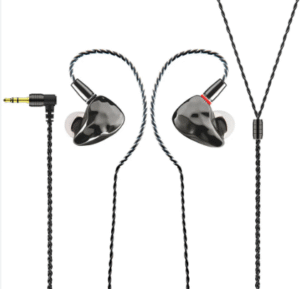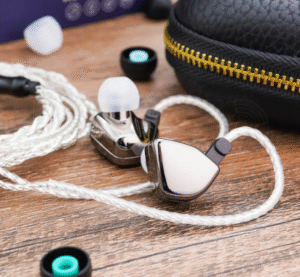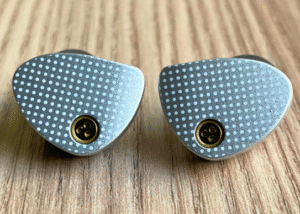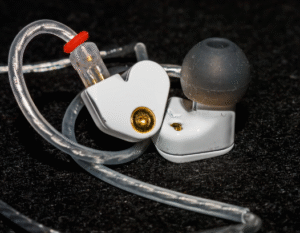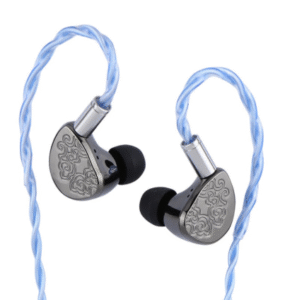When you listen to IEMs, you might want to ditch your expensive Bluetooth earphones altogether. If pure sound quality is all that matters to you, you’ll find a great pair that’s easy to find.
In this article, we’ve rounded up some of the best IEMs under $200 that offer great value for your money, but still manage to be affordable.
Each earphone has its own unique personality and will suit a variety of musical tastes. If you’re considering upgrading from your existing IEMs,
Best IEM Under $200 in 2025
1. Meze Alba
I think the Meze Alba is one of the best value options for under $200, especially because it includes a dongle DAC.
This DAC greatly improves the overall sound and soundstage. In terms of sound quality, I was particularly impressed by the excellent clarity in the treble range.
The clear clarity in the bass range adds great clarity to the overall sound and makes the bass more solid.
The bass is decent, but the versatility of this IEM really stands out to me. I can’t help but admire the Alba’s beautiful design.
It looks much more expensive than it actually is, which is always a good thing. The only downside is that since it’s brand new, it might not be in stock.
2. SeeAudio Yume
Yume is an example of giving with one hand and taking with the other. In the latter case, Yume doesn’t have good resolution.
The notes are a bit dull and muddy. In terms of imaging, I think Yume is below average for its price range. On the other hand, the tonality is best in its class.
It’s a neutral sound with a strong bass and a clean, sub-bass-centric shelf sound.
The midrange is nicely tapered along the ear canal and slopes beautifully into the highs, with a bit of spiciness added to the mids and highs to keep them from becoming too cliche.
Sure, some may find the Yume boring, but no one will say it’s bad. Add in the excellent fit, and you have a versatile IEM for those who want comfortable listening above all else.
Plus, the Yume uses a ton of expensive components for its tone!
3. DUNU Titan S
The DUNU Titan S is a great choice for those looking for a neutral sound in the budget market, where V-shaped or Harman tuning is the norm.
In addition to the analytical signature, the tonality and technical aspects are quite adequate. The Titan S is easy to drive. The accessories provided are very rich, and the construction is solid.
There is a bit of sub-bass roll-off, so it is not recommended for those with a strong bass tendency.
The nozzle is rather long, which may be uncomfortable for those with small ears, but overall, the Titan S is a very unique neutral soundscape in this price range.
4. Sennheiser IE 200
It’s no surprise that Sennheiser is featured on this list of “best” audio products. The company’s IE IEM line has been a huge success, and the IE 200 is their most affordable.
The housing is smaller than the others on this list, making it comfortable to wear for long periods of time. The sound is very vibrant, with precision, detailed imaging, and detailed performance.
The treble can get a little hot, but it matches well with the energy felt in the other sound profiles.
5. Final E4000
The biggest selling point of the Final E4000 is its excellent bass response. Thanks to Final Audio’s expert treble tuning, the bass is solid and rich, yet not muddy.
The treble is punchy, giving the drums and vocals a warm, yet powerful attack. I especially like how the vocals never sound nasal, but always sound deep and punchy.
The soundstage is wide and has a nice finish. For those who like a classic Final sound signature, I would also recommend the A4000.
I personally prefer a warmer IEM rather than a treble-focused response, so I chose the E series over the A series.
6. Ikko OH10
This is probably the least safe recommendation on this list. Unless you’re a fan of a more “Asian” sound signature with a strong emphasis on the lows and mids, don’t even consider buying this IEM.
The OH10’s bass touch is by far the best I’ve heard in this price range.
But the most surprising thing about the Ikko OH10 is that it has the best treble extension of any IEM on this list. There’s a strong peak at 15 kHz and a fair amount of buzz.
The resulting imaging is quite impressive, but whether or not it sounds good in the highs is a completely different matter. So don’t blame this IEM for sounding a bit dark.
7. HZSound Heart Mirror
The Heart Mirror is another bright and neutral product, with a great aesthetic and convenient accessories. It boasts excellent technical performance, but is harder to drive than the Titan S.
The Heart Mirror’s soundstage is unfortunately quite compressed, and the treble can be a bit stilted or lacking in bass.
The Heart Mirror is a bit less refined in terms of tone, timbre, and technical aspects than the Titan S. However, the Titan S is much cheaper, making it a great choice for those on a tight budget.
8. Moondrop Aria 2
The Moondrop Aria 2 offers the closest frequency response to the Harman Curve of any IEM on this list. I find it very neutral and usable for all genres of music.
Its high sensitivity makes it easy to drive even with a phone, making it a perfect daily IEM. At a low price of $90, the Aria 2 is the most versatile IEM on this list, offering great value for the money.
It doesn’t change the sound signature much, so some people might find it boring. On the other hand, if you like a dry and analytical sound, this is a great choice.
9. Moondrop SSR
There is no bass (if you want more bass, go with the SSP), the mids are ridiculously forward due to the 13dB of treble compensation, and the highs are somewhat overemphasized in the mids, which doesn’t show up in the graph. In terms of tone, the SSR’s sharp and sharp tone is really unbearable.
However, it has the best technology that a $50 speaker can’t handle. One of the first things you’ll notice about the SSR is its transient response. It’s the sharpest IEM I’ve ever heard in its class.
The SSR’s layering also helps with the overall imaging by providing ample space between instruments. If you have strong ears or are sensitive to tuning, you should definitely consider the SSR.
10. Tangzu Audio Zetian Wu
In the current craze for planar IEMs, where planar IEMs are being released like candy every few days, most planar IEMs boast lightning-fast transients and class-leading technical features.
However, this is a double-edged sword. Fast transients can result in a lack of sub-bass amplitude and decay, and can make the tone unnaturally dull.
Also, many planar IEMs offer good airiness and extension, but come at the expense of harsh treble.
Introducing the Tangzu Audio Zetian Wu. This planar IEM features a U-shaped balanced profile that delivers excellent weight and realistic timbre.
The Zetian Wu is arguably the most balanced headphone in existence, boasting a very stable and fatigue-free treble. It is also great for long-term listening, with an excellent fit.
The Zetian Wu is relatively easy to drive, but when connected to an amplifier, it has excellent extension without distortion.
FAQs
What are IEMs used for?
IEMs (in-ear monitors) are designed to allow sound mixers and performing musicians to enjoy a variety of music sources on stage.
For example, a guitarist in a band can hear the sound of various instruments and vocals directly in his or her ears, thereby blocking out the cheers and shouts of the audience.
IEMs are typically made to fit the shape of the performer’s ear canal.
IEMs consist of three components: a transmitter that transmits audio to a receiver, a receiver that the performer wears and inserts an earpiece into, and an earphone that cancels out noise and outputs a clear sound.
IEMs were originally designed for performing musicians and singers, but are now available to audio enthusiasts at a variety of price points.

Do IEMs sound better than earbuds?
IEMs sound better than earbuds because they are placed in the ear canal, and the technology used to emit sound is different.
IEMs are positioned inside the ear canal, while regular earbuds are positioned just outside the ear canal.
That is, they are very effective at blocking out ambient noise and isolating the music.
Also, most earbuds only have 1-2 drivers in each earbud. IEMs use 2-6 drivers, each driver focusing on a specific frequency.
Will IEMs cause pain in my ears?
IEMs should not cause pain in your ears and should be comfortable to wear. They should fit exactly into the shape of your ear canal.
If you don’t fit them properly and wear them for long periods of time, your ears may hurt. Also, if you insert the IEM too deeply into your ear canal, it can cause pain.
If you are new to IEMs, try them out before you put them on.
Conclusion
All of these IEMs under $200 offer great value and are suitable for a variety of sound preferences and use cases.
As always, personal taste plays a big role in choosing the right IEM for you, so if possible, try them out yourself before making a final decision.
Also Read: Balanced Armature vs Dynamic Driver?

